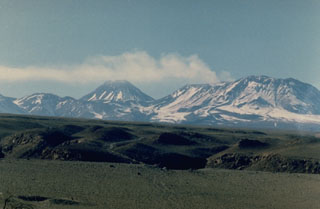Report on Lascar (Chile) — 18 June-24 June 2025
Smithsonian Institution / US Geological Survey
Weekly Volcanic Activity Report, 18 June-24 June 2025
Managing Editor: Sally Sennert.
Please cite this report as:
Global Volcanism Program, 2025. Report on Lascar (Chile) (Sennert, S, ed.). Weekly Volcanic Activity Report, 18 June-24 June 2025. Smithsonian Institution and US Geological Survey.
Lascar
Chile
23.37°S, 67.73°W; summit elev. 5592 m
All times are local (unless otherwise noted)
The Servicio Nacional de Geología y Minería (SERNAGEOMIN) reported declining seismicity, low sulfur dioxide emissions, and no deformation at Láscar in recent weeks. During 1-15 June sulfur dioxide emissions measured at a station 6 km ESE averaged 1,254 tonnes per day (t/d) with a maximum value of 2,572 t/d on 12 June. No anomalous emissions were detected in satellite data. White gas plumes visible in webcam views rose as high as 400 m above the crater rim and drifted ESE. Incandescence from the crater was visible during 6, 9-10, and 15 June, and periodically at night through the first half of June. Satellite data continued to show three zones of elevated temperatures on the crater floor. The seismic network recorded fewer and less intense signals indicative of volcanic processes. The Alert Level was lowered to Green (the lowest level on a four-color scale).
Geological Summary. Láscar is the most active volcano of the northern Chilean Andes. The andesitic-to-dacitic stratovolcano contains six overlapping summit craters. Prominent lava flows descend its NW flanks. An older, higher stratovolcano 5 km E, Volcán Aguas Calientes, displays a well-developed summit crater and a probable Holocene lava flow near its summit (de Silva and Francis, 1991). Láscar consists of two major edifices; activity began at the eastern volcano and then shifted to the western cone. The largest eruption took place about 26,500 years ago, and following the eruption of the Tumbres scoria flow about 9000 years ago, activity shifted back to the eastern edifice, where three overlapping craters were formed. Frequent small-to-moderate explosive eruptions have been recorded since the mid-19th century, along with periodic larger eruptions that produced ashfall hundreds of kilometers away. The largest historical eruption took place in 1993, producing pyroclastic flows to 8.5 km NW of the summit and ashfall in Buenos Aires.
Source: Servicio Nacional de Geología y Minería (SERNAGEOMIN)

